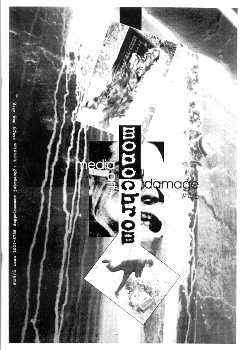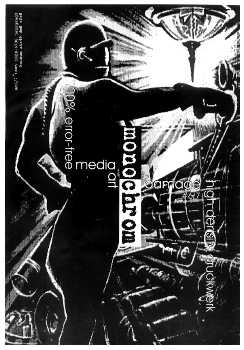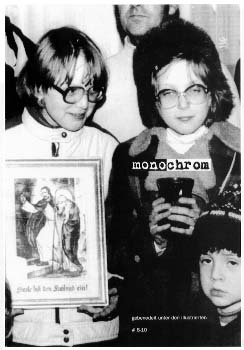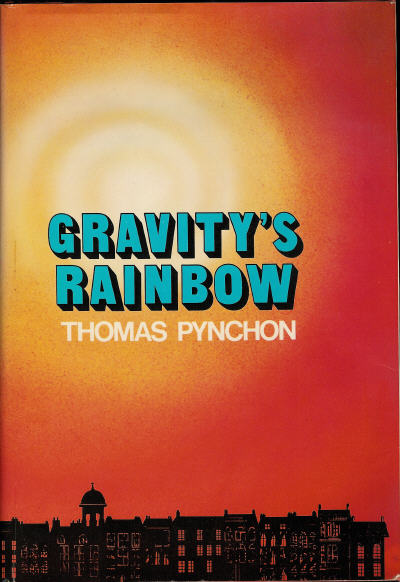monochrom, 3-10 (1994-1998) [German]
Filed under magazine | Tags: · art, conspiracy, copyleft, copyright, media, media art, media culture, net culture, philosophy, politics, science fiction, software, subversion, surveillance, tactical media, technology




The mouthpiece of an international art-technology-philosophy collective founded in 1993, with its headquarters at Museumsquartier in Vienna.
Editor-in-chief: Johannes Grenzfurthner
Publisher Monochrom, Vienna
ISSN 1024-6738
Authors
Monochrom on Wikipedia
PDF (No. 3: media dings, 1994/95, 68 pp)
PDF (No. 4-5: media art damage, 1995/96, 104 pp)
PDF (No. 6-7: 100% error free high-density druckwerk, 1997, 112 pp)
PDF (No. 8-10: gebenedeit unter den illustrierten, 1998, 180 pp)
Michael Kinsella: Legend-Tripping Online: Supernatural Folklore and the Search for Ong’s Hat (2011)
Filed under book | Tags: · conspiracy, fantasy, folklore, internet, mail art, noosphere, occultism, paranormal

“On the Internet, seekers investigate anonymous manifestos that focus on the findings of brilliant scientists said to have discovered pathways into alternate realities. Gathering on web forums, researchers not only share their observations, but also report having anomalous experiences, which they believe come from their online involvement with these veiled documents. Seeming logic combines with wild twists of lost Moorish science and pseudo-string theory. Enthusiasts insist any obstacle to revelation is a sure sign of great and wide-reaching efforts by consensus powers wishing to suppress all the liberating truths in the Incunabula Papers (included here in complete form).
In Legend-Tripping Online, Michael Kinsella explores these and other extraordinary pursuits. This is one of the first books dedicated to legend-tripping, ritual quests in which people strive to explore and find manifest the very events described by supernatural legends. Through collective performances, legend-trippers harness the interpretive frameworks these stories provide and often claim incredible, out-of-this-world experiences that in turn perpetuate supernatural legends.
Legends and legend-tripping are assuming tremendous prominence in a world confronting new speeds of diversification, connection, and increasing cognitive load. As guardians of tradition as well as agents of change, legends and the ordeals they inspire contextualize ancient and emergent ideas, behaviors, and technologies that challenge familiar realities. This book analyzes supernatural legends and the ways in which the sharing spirit of the Internet collectivizes, codifies, and makes folklore of fantastic speculation.”
Publisher University Press of Mississippi, 2011
ISBN 1604739843, 9781604739848
208 pages
review (David J. Puglia, Journal of Folklore Research)
review (Óli Gneisti Sóleyjarson, Folklore)
Legend tripping at Wikipedia
Thomas Pynchon: Gravity’s Rainbow (1973-) [EN, IT, HU]
Filed under fiction | Tags: · colonialism, conspiracy, entropy, military, sex, synchronicity, war

A few months after the Germans’ secret V-2 rocket bombs begin falling on London, British Intelligence discovers that a map of the city pinpointing the sexual conquests of one Lieutenant Tyrone Slothrop, U.S. Army, corresponds identically to a map showing V-2 impact sites. The implications of this discovery launch Slothrop on a wildly comic extravaganza.
“Gravity’s Rainbow is Pynchon’s most celebrated novel. An intricate and allusive fiction that combines and elaborates on many of the themes of his earlier work, including preterition, paranoia, racism, colonialism, conspiracy, synchronicity, and entropy, the novel has spawned a wealth of commentary and critical material, including reader’s guides, books and scholarly articles, online concordances and discussions, and art works. Its artistic value is often compared to that of James Joyce’s Ulysses. Some scholars have hailed it as the greatest American post-WW2 novel, and it has similarly been described as ‘literally an anthology of postmodernist themes and devices’.” (from Wikipedia)
A Journey Into the Mind of P, documentary on Pynchon (dir. Donatello Dubini & Fosco Dubini, 2002, 88 min)
Gravity’s Rainbow (English, 2000, EPUB)
Gravity’s Rainbow (English, undated, PDF, unpaginated)
L’arcobaleno della gravità (Italian, trans. Giuseppe Natale, 1999, no OCR, 82 MB), (OCR’d, unpaginated)
Súlyszivárvány (Hungarian, trans. János Széky, 2009, unpaginated)

